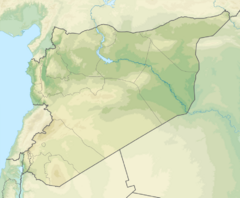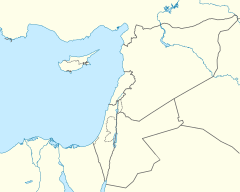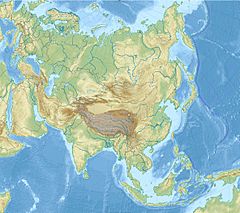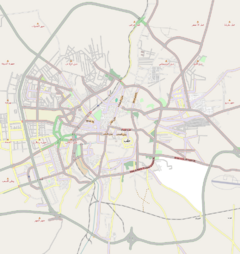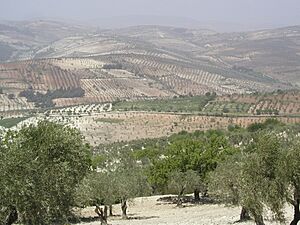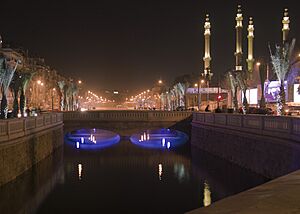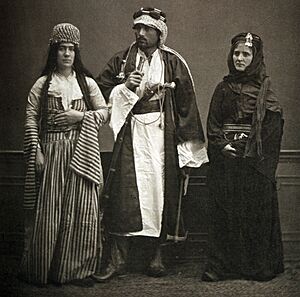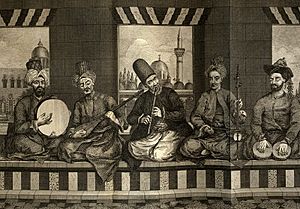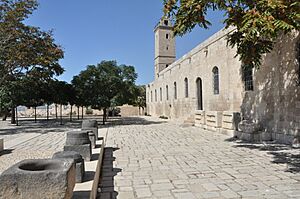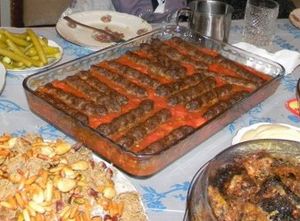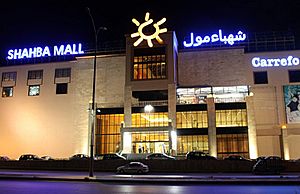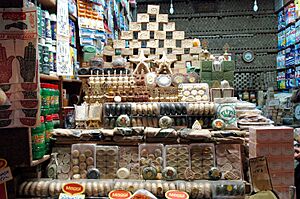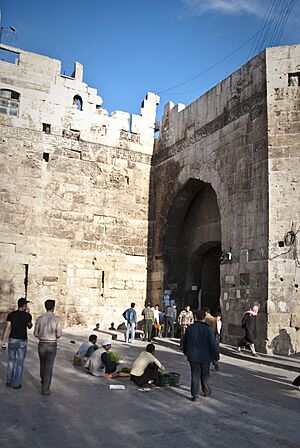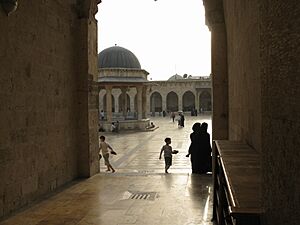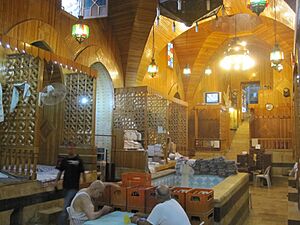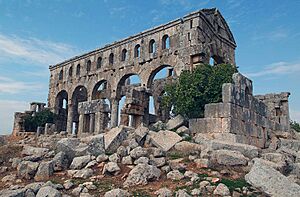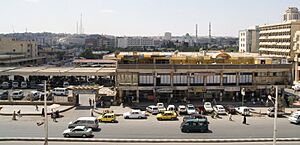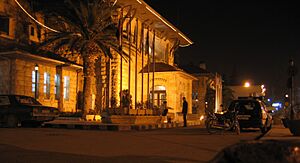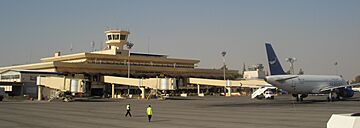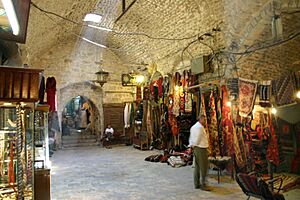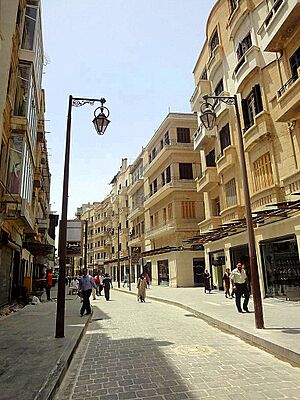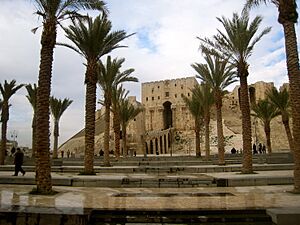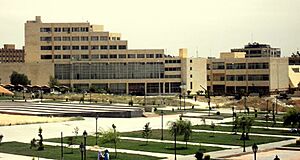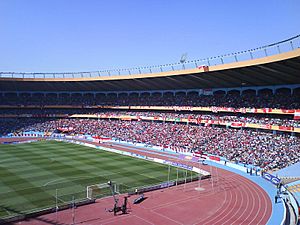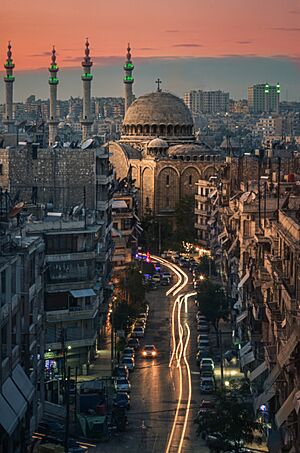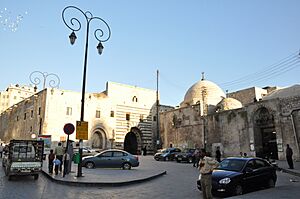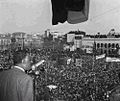Aleppo facts for kids
Quick facts for kids
Aleppo
ﺣَﻠَﺐ
|
||
|---|---|---|

Ancient City of Aleppo
Aleppo Citadel • The entrance to al-Madina Souq Great Mosque of Aleppo • Baron Hotel Saint Elijah Cathedral • Queiq River Panorama of Aleppo at night |
||
|
||
| Nickname(s): | ||
| Country | ||
| Governorate | Aleppo | |
| District | Mount Simeon (Jabal Semaan) | |
| Subdistrict | Mount Simeon (Jabal Semaan) | |
| First settled | c. 5000 BC | |
| First city council | 1868 | |
| Government | ||
| • Type | Mayor–council government | |
| Area | ||
| • Total | 190 km2 (70 sq mi) | |
| Elevation | 379 m (1,243 ft) | |
| Population
(2021 est.)
|
||
| • Total | 2,098,210 | |
| • Rank | 2nd in Syria 18th in the Arab World |
|
| • Density | 11,040/km2 (28,600/sq mi) | |
| Demonym(s) | Arabic: حلبي Ḥalabi English: Aleppine |
|
| Time zone | UTC+3 | |
| Area code(s) | Country code: 963 City code: 21 |
|
| Geocode | C1007 | |
| Climate | BSk | |
| International airport | Aleppo International Airport | |
| Sources: Aleppo city area Sources: City population | ||
| Official name: Ancient City of Aleppo | ||
| Type: | Cultural | |
| Criteria: | iii, iv | |
| Designated: | 1986 (10th session) | |
| Reference #: | 21 | |
| Region: | Arab States | |
Aleppo (pronounced ə-LEP-oh) is a major city in Syria. It's the capital of the Aleppo Governorate, which is the most populated area in Syria. With over 2 million people in 2021, Aleppo is one of the largest cities in the Levant region.
Aleppo is one of the oldest cities in the world where people have lived continuously. It might have been settled as early as 6000 BC! Its long history is due to its great location. It was a key trading spot between the Mediterranean Sea and Mesopotamia. For many centuries, Aleppo was the biggest city in the Syrian region. It was also the third-largest city in the Ottoman Empire, after Istanbul and Cairo. Aleppo was very important because it was at one end of the famous Silk Road. This ancient trade route connected the East and West.
However, when the Suez Canal opened in 1869, much of the trade moved to sea routes. This caused Aleppo to slowly decline. After World War I, Aleppo lost some of its northern lands to modern Turkey. It also lost important railway connections. The city faced a lot of destruction during the Syrian Civil War (2012–2016). Many parts of the city were badly damaged. Today, affected areas are being rebuilt. The city also suffered some damage from the 2023 Turkey-Syria earthquake.
Contents
What's in a Name?
People today often call the city Aleppo. In ancient times, it was known as Khalpe or Beroea by the Greeks and Romans. The name Alep was used during the Crusades and later when France governed Syria. Aleppo is the Italian version of this name.
The original ancient name, Ḥalab, is still the Arabic name for the city. No one is completely sure where this name came from. Some think Ḥalab means "iron" or "copper" in the Amorite language. This is because the area was a big source of these metals long ago. Another idea is that Ḥalab means 'white' in Aramaic. This might explain why the city's modern Arabic nickname is al-Shahbāʾ. This nickname means "white-colored mixed with black." It might come from the white marble found in Aleppo.
A popular old story says the name comes from the word for 'milk'. This is because Abraham supposedly milked his sheep here to feed the poor.
A Look Back in Time
Ancient History
Aleppo's story goes back about 10,000 years! Archeologists have found signs of people living here around 8000 BC. The city was known as Ḥalab (or Ḥalba). It was the capital of a powerful kingdom called Yamḥad around 1800–1600 BC.
Aleppo was also a very important religious center. People especially worshipped the storm god Hadad here. Its importance continued under different empires, like the Hittites and Assyrians. Everyone knew how important its location was.
Medieval Times
In 637 AD, Arab forces took over Aleppo. The city went back to its Arabic name, Ḥalab. Aleppo grew and became very successful under Islamic rule. In the 10th century, it even became its own independent state.
During this time, Aleppo was a center for culture. Poets and thinkers gathered there. The city also played a big role in stopping the Crusader armies in the 12th century.
Mongol Invasions and Ottoman Rule
In 1260, the Mongols attacked Aleppo. This caused a lot of damage and loss of life. Even though the Mongols were soon driven out, the city faced more challenges. These included diseases and more invasions, like by Timur in 1400.
Aleppo became part of the Ottoman Empire in 1516. It once again became a major trade center. This was thanks to its location on important trade routes. By the 16th century, it was one of the largest cities in the Ottoman Empire.
Modern Times
In the late 1700s, trade in Aleppo started to slow down. This was due to new ways of transportation and problems within the Ottoman Empire. Still, Aleppo remained culturally important.
Before the recent civil war, Aleppo was one of the fastest-growing cities in the Middle East. It was even named the "capital of Islamic culture" in 2006. However, the Syrian Civil War (which started in 2011) caused huge damage. More than 30% of its historic buildings were destroyed. This war greatly changed the city and its people.
City Layout and Weather
Aleppo is about 120 kilometers (75 miles) inland from the Mediterranean Sea. It sits on a plateau about 380 meters (1,247 feet) above sea level. To the north and west, you'll find farms with olive and pistachio trees. To the east, Aleppo is close to the dry Syrian Desert.
The city was first built a few kilometers south of where the old city is now. It was on the right bank of the Queiq River. This river starts in the north and flows south through Aleppo. The old city of Aleppo is on the left bank of the Queiq. It was once surrounded by eight hills and a central hill with a castle. The old city used to have a wall with nine gates, but it's gone now.
Aleppo is a fast-growing city. It covers an area of over 190 square kilometers (73 square miles). There are plans to make it even bigger.
Climate of Aleppo
Aleppo has a cool, dry climate. Mountains near the Mediterranean coast block most of the rain. The average high temperature is about 23.8°C (74.8°F), and the average low is 11.1°C (52°F). Most of the rain falls between October and March. It usually snows once or twice each winter.
| Climate data for Aleppo (Aleppo International Airport), 393 metres (1,289 feet) above sea level, 1991–2020 normals | |||||||||||||
|---|---|---|---|---|---|---|---|---|---|---|---|---|---|
| Month | Jan | Feb | Mar | Apr | May | Jun | Jul | Aug | Sep | Oct | Nov | Dec | Year |
| Record high °C (°F) | 20.5 (68.9) |
25.4 (77.7) |
29.8 (85.6) |
38.6 (101.5) |
41.0 (105.8) |
44.0 (111.2) |
45.7 (114.3) |
44.3 (111.7) |
44.0 (111.2) |
39.0 (102.2) |
29.7 (85.5) |
24.5 (76.1) |
45.7 (114.3) |
| Mean daily maximum °C (°F) | 10.7 (51.3) |
12.9 (55.2) |
17.6 (63.7) |
23.1 (73.6) |
29.4 (84.9) |
34.2 (93.6) |
36.8 (98.2) |
36.8 (98.2) |
33.5 (92.3) |
27.6 (81.7) |
18.8 (65.8) |
12.2 (54.0) |
24.5 (76.0) |
| Mean daily minimum °C (°F) | 2.4 (36.3) |
3.2 (37.8) |
6.1 (43.0) |
10.0 (50.0) |
15.0 (59.0) |
19.8 (67.6) |
22.8 (73.0) |
22.8 (73.0) |
19.4 (66.9) |
14.2 (57.6) |
7.3 (45.1) |
3.7 (38.7) |
12.2 (54.0) |
| Record low °C (°F) | −11.3 (11.7) |
−8.3 (17.1) |
−5.5 (22.1) |
−4.0 (24.8) |
5.0 (41.0) |
10.0 (50.0) |
12.0 (53.6) |
12.1 (53.8) |
6.0 (42.8) |
−2.0 (28.4) |
−12.0 (10.4) |
−10.8 (12.6) |
−12.0 (10.4) |
| Average precipitation mm (inches) | 57.5 (2.26) |
47.8 (1.88) |
42.4 (1.67) |
27.8 (1.09) |
16.0 (0.63) |
1.7 (0.07) |
0.0 (0.0) |
0.1 (0.00) |
3.5 (0.14) |
23.0 (0.91) |
35.6 (1.40) |
58.3 (2.30) |
313.7 (12.35) |
| Average precipitation days (≥ 1.0 mm) | 9.0 | 7.6 | 6.8 | 4.3 | 2.7 | 0.3 | 0.0 | 0.0 | 0.5 | 3.4 | 4.9 | 8.0 | 47.5 |
| Average relative humidity (%) | 84 | 79 | 68 | 65 | 50 | 42 | 42 | 45 | 46 | 55 | 66 | 80 | 60 |
| Mean monthly sunshine hours | 120.9 | 140.0 | 198.4 | 243.0 | 319.3 | 366.0 | 387.5 | 365.8 | 303.0 | 244.9 | 186.0 | 127.1 | 3,001.9 |
| Mean daily sunshine hours | 3.9 | 5.0 | 6.4 | 8.1 | 10.3 | 12.2 | 12.5 | 11.8 | 10.1 | 7.9 | 6.2 | 4.1 | 8.2 |
| Source 1: NOAA (sun 1961–1990) | |||||||||||||
| Source 2: Deutscher Wetterdienst (humidity 1960–1967, extremes 1951–1978) | |||||||||||||
Architectural Styles
Aleppo has a mix of building styles because different groups ruled it over time. These included Romans, Byzantines, and Ottomans.
The old city has many buildings from the 13th and 14th centuries. These include inns for travelers (caravanserais), schools, and religious buildings. The al-Jdayde area has beautiful 16th and 17th-century houses with stone carvings. Newer areas show styles from the 19th and 20th centuries, like Baroque architecture.
There's a clear difference between old and new Aleppo. The older part, about 160 hectares (400 acres) big, was inside a wall. The huge medieval castle sits in the center of the old city.
Because of many invasions, people built their neighborhoods to be somewhat separate. Each area often had people of similar religions or backgrounds. The old town was mostly built with white stone. The newer parts of the old city were first built by Christians in the 15th century. This was after the Mongols left Aleppo. The al-Jdayde quarter is a great example of these unique neighborhoods.
The Old City of Aleppo covers about 350 hectares (860 acres) and is home to over 120,000 people.
People of Aleppo
Population History
| Historical population | ||
|---|---|---|
| Year | Pop. | ±% |
| 1883 | 99,179 | — |
| 1901 | 108,143 | +9.0% |
| 1922 | 156,748 | +44.9% |
| 1925 | 210,000 | +34.0% |
| 1934 | 249,921 | +19.0% |
| 1944 | 325,000 | +30.0% |
| 1950 | 362,500 | +11.5% |
| 1960 | 425,467 | +17.4% |
| 1965 | 500,000 | +17.5% |
| 1983 | 639,000 | +27.8% |
| 1990 | 1,216,000 | +90.3% |
| 1995 | 1,500,000 | +23.4% |
| 2000 | 1,937,858 | +29.2% |
| 2004 | 2,132,100 | +10.0% |
| 2005 | 2,301,570 | +7.9% |
| 2016 | 1,800,000 | −21.8% |
| 2021 | 2,098,210 | +16.6% |
| Source | ||
Before a big earthquake in 1822, Aleppo's population was around 400,000. After the earthquake and some diseases, the population dropped to about 110,000 by the late 1800s. In 1901, most people were Muslims (about 70%), with Christians (about 22%) and Jews (about 6%) also living there.
Aleppo's Christian population grew in the early 1900s. Many Armenian and Assyrian Christians came as refugees. By 1922, Armenians made up about 12% of the city's population. More Armenians arrived between 1923 and 1925, making up over a quarter of the city's people.
Before the civil war, Aleppo was Syria's most populated city, with over 2.1 million people in 2004. However, the war caused many people to leave.
Religious Groups
Most of Aleppo's people are Sunni Muslims. These are mainly Syrian Arabs, along with some Turkmens and Kurds.
Until the civil war began in 2012, Aleppo had one of the largest Christian communities in the Middle East. There were many different Christian groups, including Armenians and Assyrians. Before the war, Christians made up about 12% of the city's population. However, the war caused this number to drop. Many churches were damaged during the fighting.
Aleppo was also home to a large Jewish population for a long time. The Great Synagogue, built in the 5th century, once held the famous Aleppo Codex. After the Spanish Inquisition, many Jewish families from Spain moved to Aleppo. Peaceful relations existed between Jews and others. However, after 1948, many Jews left Aleppo. Today, very few Jewish families remain.
Languages Spoken
The Arabic spoken in Aleppo is a type of Syrian Arabic. It has many words from the Syriac language. Kurdish is the second most spoken language in the city. Most Armenians speak Western Armenian. The Syriac language is mostly used in church services. People also speak some English and French.
Culture and Fun
Art and Music
Aleppo is known as a major center for traditional Arabic music. It's famous for its Muwashshahs and Qudud Halabiya (special types of songs). In 2021, the Qudud Halabiya was added to UNESCO's list of important cultural heritage.
People in Aleppo love classical Arab music. Many famous Arab musicians visited Aleppo to learn from its musical traditions. Aleppine musicians say that no major Arab artist became famous without getting approval from the city's "connoisseur listeners" (called sammi'a).
Aleppo hosts many music shows and festivals at the Citadel amphitheater. These include the "Syrian Song Festival" and the "Silk Road Festival."
Museums to Explore
- National Museum of Aleppo
- Museum of Popular Traditions (at Beit Achiqbash)
- Aleppo Citadel Museum
- Museum of Medicine and Science (at Bimaristan Arghun al-Kamili)
- Aleppo Memory Museum (at Beit Ghazaleh)
- Zarehian Treasury of the Armenian Apostolic Church
Delicious Food
Aleppo is surrounded by olive, nut, and fruit farms. Its food is famous because of this rich land and its location on the Silk Road. In 2007, Aleppo won a culinary award from France!
The city has many different dishes. These include kebab, kibbeh, dolma, and hummus. Ful halabi is a common breakfast dish. It's a fava bean soup with olive oil, lemon juice, garlic, and Aleppo's red peppers. The za'atar (thyme) from Aleppo is also very popular.

Kibbeh is one of the most loved foods. Aleppines have created over 17 types of kibbeh! These include kibbeh with sumac, yogurt, quince, or cherry sauce. Kebab Halabi has about 26 different kinds. These include kebab with cherry, eggplant, or chili pepper. The favorite drink is Arak, often enjoyed with small dishes called meze. Local wines and brandies are also popular.
Aleppo is also known for its many sweets and pastries. These often contain lots of butter and sugar. Many pastries use the famous Aleppine pistachios.
Fun and Entertainment
Before the civil war, Aleppo was known for its lively nightlife. There were many clubs, bars, and cafes. The historic al-Jdayde area was famous for its pubs and hotels in old mansions. They offered special Aleppine food and music.
The Aleppo Public Park, opened in 1949, is one of Syria's largest parks. It's located near the Queiq River. The Blue Lagoon water park was also a favorite spot. Aleppo's Shahba Mall was one of the biggest shopping centers in Syria. Both were badly damaged during the civil war.
Historic Places to See
Souqs and Khans
Aleppo's location made it a great trading city. People from all over came to trade goods from places like China, India, and Egypt. The largest covered market in the world is in Aleppo. It's about 13 kilometers (8 miles) long!
This market, called Al-Madina Souq, is still a busy place. You can find imported goods like silk from Iran, spices from India, and coffee. It also sells local products like wool and soap. Most of the market dates back to the 14th century. Different sections are named after the crafts sold there, like the copper market. Besides shops, the market had khans (inns for traders) and caeserias (workshops for craftsmen).
Gates and Buildings
The old part of the city was surrounded by thick walls, about 5 kilometers (3 miles) long. These walls had nine historic gates, many of which are still standing. They are:
- Bab al-Hadid
- Bab al-Ahmar
- Bab al-Nairab
- Bab al-Maqam
- Bab Qinnasrin
- Bab Antakeya
- Bāb Jnēn
- Bab al-Faraj
- Bab al-Nasr
Some important historic buildings include:
- The Citadel: A huge fortress on a hill, rising 50 meters (164 feet) above the city. It dates back to ancient times, with many current parts from the 13th century.
- Al-Shibani building, al-Halawiyah Madrasa, and al-Firdaws Madrasa (old schools).
- Beit Junblatt and Beit Ghazaleh (historic mansions).
- Bab al-Faraj Clock Tower.
Places of Worship
- Great Mosque of Aleppo: Started around 715 AD. It has a tomb linked to Zachary, the father of John the Baptist. Its tall tower, built in the 11th century, was sadly destroyed during the civil war in 2013.
- Al-Nuqtah Mosque: A mosque for Shia Muslims. It has a stone said to be marked by a drop of Husayn's blood.
- Many other mosques like Al-Shuaibiyah Mosque and Khusruwiyah Mosque.
- Churches in the al-Jdayde quarter: These include the Forty Martyrs Cathedral (Armenian Apostolic), the Church of the Dormition of Our Lady (Greek Orthodox), and the Maronite Cathedral of Saint Elijah.
- Central Synagogue of Aleppo: This synagogue dates back to the 9th century. It was damaged in 1947 and again during the civil war.
Hammams (Public Baths)
Aleppo used to have 177 public baths (hammams) in medieval times. Before the civil war, 18 hammams were still working in the old city. Some famous ones include:
- Hammam al-Nahhasin: Built in the 12th century.
- Hammam al-Sultan: Built in 1211.
- Hammam al-Bayadah: From the 15th century.
- Hammam Yalbugha: Built in 1491.
Nearby Attractions: The Dead Cities
Just outside Aleppo, to the west, are the "Dead Cities." These are about 700 abandoned settlements from before the 5th century. They have remains of old Christian Byzantine buildings. Many are in the Mount Simeon and Jabal Halaqa regions. The Dead Cities became a UNESCO World Heritage Site in 2011.
Some notable sites include:
- Kharab Shams Byzantine basilica (4th century).
- The ruins of a Roman basilica in Fafertin (372 AD).
- The old Byzantine village of Surqanya.
- The Church of Saint Simeon Stylites (5th century).
- The ancient city of Cyrrhus with its Roman amphitheater.
Getting Around Aleppo
Roads and Highways
The main highway is the M4 Highway. It runs along the Queiq River. You can connect to the M5 Highway to go south to Homs and Damascus. To the north, Castello Road leads to the border with Turkey.
Public Transport
Aleppo has a good public transport system with buses and minibuses. New buses connect the city with Damascus and other Syrian cities. There are also local and inter-city taxis.
Railway
Aleppo was an important stop on the Baghdad Railway in 1912. Train connections to Turkey still exist. Aleppo is the headquarters for Syria's national railway network. The railway was badly damaged during the civil war. However, rebuilding started in 2020 to bring train travel back.
The famous book Murder on the Orient Express by Agatha Christie starts at the railway station in Aleppo!
Airport
Aleppo International Airport is the city's international airport. It's a secondary hub for Syrian Arab Airlines. The airport was closed in 2013 due to fighting. But after the Syrian government took back eastern Aleppo, planes started flying from there again in 2017.
Aleppo's Economy
Trade and Industry
Aleppo has always been a major trading city. It was at the center of trade routes from India, Mesopotamia, and Damascus. Even when trade routes changed, Aleppo kept thriving.
The Aleppo Chamber of Commerce, founded in 1885, is one of the oldest in the Middle East. Many historians say Aleppo was the most developed commercial and industrial city in the Ottoman Empire after Istanbul and Cairo.
Before the civil war, Aleppo was known as the capital of Syrian industry. Its economy was mainly based on textiles, chemicals, medicines, food processing, and tourism. It produced over 50% of Syria's manufactured goods.
Aleppo is also a major center for making things with precious metals and stones. About 40% of all gold made in Syria comes from Aleppo. The industrial city in Sheikh Najjar is one of the largest in the region. It has attracted billions of dollars in investments.
Traditional crafts are still important in the old city. The famous Aleppo soap is thought to be the world's first hard soap.
Construction and Development
In the 2000s, Aleppo was one of the fastest-growing cities. Many people moved there for better jobs. This led to new neighborhoods being built.
Two big projects are happening in Aleppo: the "Old City Revival" and "Reopening of the Queiq River." The Old City project aims to protect the historic souqs and buildings. The Queiq River project is bringing the river back to life. Its flow was blocked in the 1960s, but pure water was restored in 2008.
Learning in Aleppo
Aleppo has many schools and colleges. In September 2018, over 1,280 schools in Aleppo and its suburbs welcomed 485,000 students.
The University of Aleppo is a large university with over 60,000 students. It has 18 faculties and 8 technical colleges. There are also two private universities in the city: al-Shahba University and Mamoun University for Science and Technology. Aleppo also has Christian schools and international schools.
Sports in Aleppo
Aleppo is a big center for team sports, especially football. The five main sports clubs are al-Ittihad SC, al-Hurriya SC, al-Yarmouk SC, Jalaa SC, and Ouroube SC.
Basketball is also popular. Jalaa SC and Al-Ittihad SC were champions of the Syrian Basketball League for many years. In July 2022, international basketball matches were played in Aleppo for the first time since the civil war.
Other sports played include tennis, handball, volleyball, and swimming. The Aleppo International Stadium is the largest sports venue in Syria, with 53,200 seats.
On January 29, 2017, Aleppo hosted its first sports event since 2012. Local football teams al-Ittihad SC and al-Hurriya SC played a match.
City Government
Aleppo is the capital of the Aleppo Governorate. The Aleppo City Council manages the city. The first city council was formed in 1868. The mayor directly manages the city.
City Areas
Aleppo's areas can be grouped into four types:
- Old areas inside the ancient city walls.
- Old areas outside the ancient city walls.
- Modern neighborhoods, including a new area called The New Aleppo.
- Informal settlements (areas that grew without official planning).
Protecting the Ancient City
Aleppo's old markets (souqs), inns (khans), baths (hammams), schools (madrasas), mosques, and churches need care. After World War II, new roads were cut through the city. Many old buildings were torn down for modern apartments. But people realized how important this history was. In 1979, a new plan was made to protect Aleppo's traditional style. This led to UNESCO declaring the Old City of Aleppo a World Heritage Site in 1986.
Many international groups are working with local authorities to restore the old city. They want to keep its history alive while allowing modern life to continue.
Sister Cities
Aleppo is twinned with these cities:
Images for kids
-
The ruins of the Maronite basilica in Barad.
-
1842 daguerreotype by Joseph-Philibert Girault de Prangey (earliest photo of the city).
-
The 17th-century oriental mansion of Beit Ghazaleh.
-
Destroyed SAA tank in the city in October 2012.
See also
 In Spanish: Alepo para niños
In Spanish: Alepo para niños



